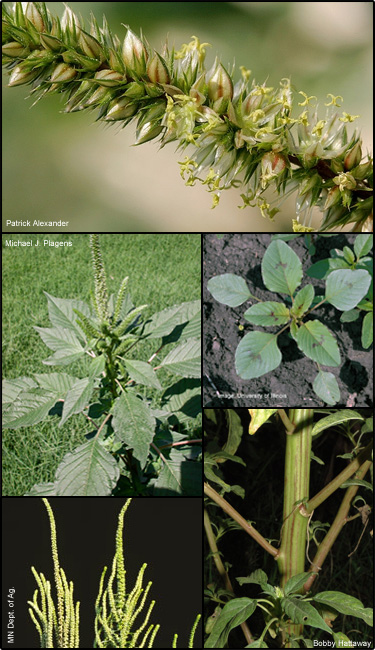Palmer amaranth (Amaranthus palmeri)
 Common Names: Palmer pigweed, careless weed
Common Names: Palmer pigweed, careless weedDescription: Considered one of the most troublesome, widespread, and economically damaging agricultural weed in the United States.
Habit: Summer annual that reaching a height of 6-8 ft. but can sometimes grow to 10 ft. or more.
Leaves: Petiole longer than leaf, alternate, ovate to diamond-shaped, some leaves have a whitish chevron or v shaped mark on them.
Stems: Tall, erect, branching, 6-8 sometimes 10 ft or more in height.
Flowers: Male and female flowers borne on separate plants. Small, inconspicuous, clustered tightly in linear or sparingly branched terminal spikes, 18 in. long.
Fruit and seeds: Shiny, dark reddish brown to brown in color, 1-1.2 mm. in diameter.
Habitat: Native to southwestern United States and northern Mexico. Can be found typically in hot, arid habitats but can also be found in crop fields and disturbed sites.
Reproduction: By seed. Capable of producing 250,000 seeds per plant.
Similar species: Native pigweed such as tall waterhemp (Amaranthus tuberculatus), redroot pigweed (Amaranthus retroflexus), Smooth pigweed (Amaranthus hybridus).
Monitoring and rapid response: Mowing alone is not effective. The use of cereal rye cover crops can reduce germination and growth. Resistant to multiple herbicides including ALS inhibitors, triazines, HPPD inhibitors, dinitroanilines, and glyphosate. Credits: The information provided in this factsheet was gathered from the Invasive Plant Atlas of the United States and the Minnesota Department of Agriculture.
Individual species images that appear with a number in a black box are courtesy of the Bugwood.org network (http://www.invasive.org). Individual photo author credits may not be included due to the small display size of the images and subsequent difficulty of reading the provided text. All other images appear courtesy of Google (http://images.google.com).
Common Name: | Palmer amaranth |
Scientific Name: | Amaranthus palmeri |
Family: | Amaranthaceae (Amaranth) |
Duration: | Annual |
Habit: | Herbs |
USDA Symbol: | AMPA |
